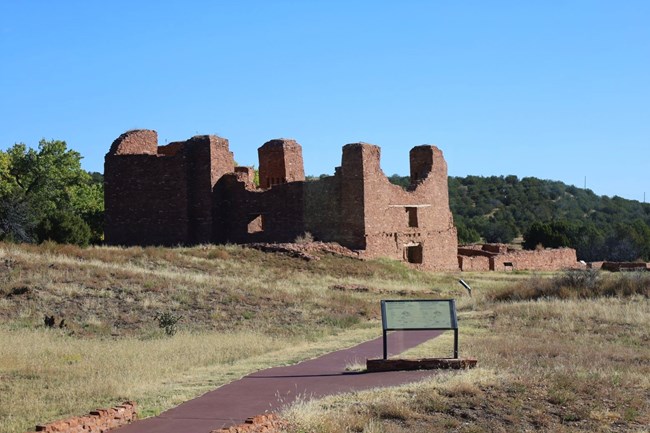|
Three distinct locations in the Salinas Pueblo Missions National Monument, located in central New Mexico, illustrate the early interactions between the Spanish and Pueblo cultures. Historically, the Salinas Province was known for its thriving Puebloan trading communities. However, by the late 1670s, the entire Salinas District had seen a decline in its population. Today, only the partially excavated pueblo of Las Humanas, also known as Gran Quivira, along with the remnants of four mission churches, remains. Each of the three separate units of the monument, Quarai, Abó, and Gran Quivira, features ancient buildings, American Indian pueblos, and Spanish missions dating back to the 17th century. At each site, including the main visitor center in Mountainair, New Mexico, there are visitor centers, picnic areas, and interpretive trails.

NPS Photo / Chris Arendt ABOThe Abó Unit of Salinas Pueblo Missions National Monument covers about 370 acres and is located to the west of Mountainair, New Mexico. When the Spanish arrived in 1581, they would have found a thriving town, evident from the numerous and large unexcavated pueblo mounds. For anyone interested in history and cultural connections, the Abó mission is a must-see spot that offers a special insight into New Mexico's rich cultural heritage. The Abó mission was built by early Spanish settlers in the 1600s and is now part of the Salinas Pueblo Missions National Monument. This site features a convento living area with a circular kiva chamber, likely used by priests to convert the Puebloan people to Christianity, along with two churches, one built in the 1620s and the other in 1640. The square is filled with homes, kivas for religious ceremonies, and horno ovens for baking bread. The low mounds give a sense of the once-busy community that thrived here. On-site displays showcase important details about the architecture and artifacts found during excavations. As people returned to inhabit Abó in the 1800s, paths leading away from the main complex guided visitors to other cultural remnants, including the ruins of later homesteads. 
NPS Photo / Alex Arnold Gran Quivira

NPS Photo / Alex Arnold QuaraiThe cultural conflict between the Puebloans and Spanish colonists in the 1600s is illustrated at Quarai. Under the guidance of Fray Juan Gutierrez de la Chica, Pueblo workers built the impressive church, convento apartments, and the nearby kiva, which were established in 1626 by Spanish Franciscan friars. The Mission Purísima Concepcion de Quarai, completed in 1632, didn't serve its religious purpose for very long. People decided to leave the pueblo in the early 1670s because of various difficulties. The restored mission chapel and the weathered sandstone walls remind us of Quarai's rich history. In Quarai, the southernmost Tiwa pueblo, you can find a prehistoric village, a large Tiwa pueblo from the 17th century, a Spanish Franciscan mission, a small church from the 19th century, a ranchero compound, and other related structures and artifacts. |
Last updated: May 26, 2025
